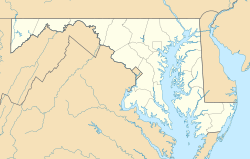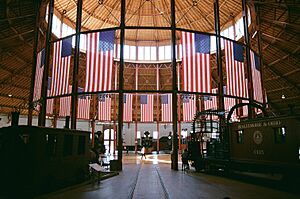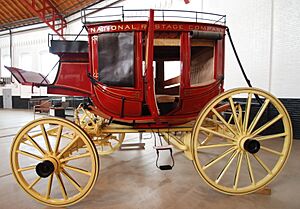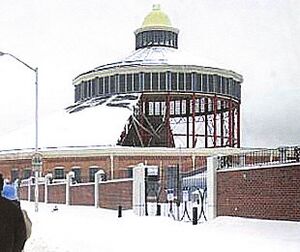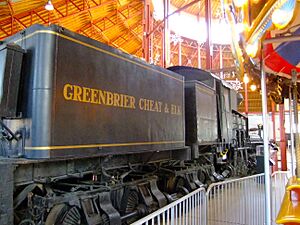- This page was last modified on 17 October 2025, at 10:18. Suggest an edit.
B&O Railroad Museum facts for kids
|
Baltimore and Ohio Railroad Museum and Mount Clare Station
|
|
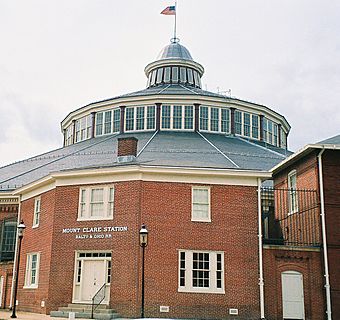
Mount Clare Station and roundhouse
|
|
| Location | 901 West Pratt Street Baltimore, Maryland, U.S. |
|---|---|
| Built | 1829 (original site) 1851 (current station structure) 1884 (roundhouse) |
| Architect | Ephraim Francis Baldwin |
| Architectural style | Georgian |
| Website | http://www.borail.org/ |
| NRHP reference No. | 66000906 |
| Significant dates | |
| Added to NRHP | October 15, 1966 |
| Designated NHL | September 15, 1961 |
The B&O Railroad Museum is an exciting place in Baltimore, Maryland, where you can explore the history of trains! It's located at the old Mount Clare Station and a large roundhouse. This museum is famous for having one of the best collections of railroad treasures in the world. It also has the largest collection of 19th-century (1800s) locomotives in the United States.
The museum sits on 40 acres of what was once the huge Mount Clare Shops site. This is a very special place because, in 1829, the Baltimore and Ohio Railroad (B&O) started America's first railroad here. It's the oldest railroad manufacturing area in the United States.
Mount Clare is often called the "birthplace of American railroading." The first regular train service for passengers in the U.S. began here on May 22, 1830. This site also received the very first telegraph message, "What hath God wrought?", sent from Washington, D.C., on May 24, 1844. This message used Samuel Morse's electric telegraph.
The museum has many cool things from the 1800s and 1900s that tell the story of American railroads. You can see 250 different train cars and engines, 15,000 other items, and lots of old documents. There are also four important 19th-century buildings, including the famous roundhouse. The museum even has a mile of track, which is considered the most historic mile of railroad track in the United States!
You can take train rides on this historic mile of track from April to December (Wednesday through Sunday) and on weekends in January. The museum also has fun model train displays. There's a big outdoor G-scale layout, two indoor HO scale models, and a wooden model train that kids can climb on. During the holidays, local model train clubs set up huge displays inside the roundhouse and around the museum grounds. Don't forget to check out the museum store for train-themed toys, books, and more!
The museum and station were recognized as a U.S. National Historic Landmark in 1961. In 2008, the museum won three awards from Nickelodeon's Parents' Picks Awards. These awards were for Best Museum for Little Kids, Best Indoor Playspace for Little Kids, and Best Indoor Playspace for Big Kids.
The museum has also found records of 24 people who sought freedom using the B&O Railroad as part of the Underground Railroad. Eight of these journeys passed through the historic Mount Clare site. In 2021, the museum's Mount Clare Station building was named a National Park Service Underground Railroad Network to Freedom site. This means it's an important place in the history of freedom.
Every year, the museum hosts a special "Day Out with Thomas" event. You can even see a replica of Thomas the Tank Engine!
How the Museum Started
The very first B&O train, pulled by horses, traveled about 13 miles (21 km) from Mount Clare to Ellicott Mills (now Ellicott City, Maryland) on May 22, 1830. This was the first time regular passenger train service was offered in the U.S. The brick building you see today as Mount Clare station was built in 1851. The large roundhouse next to it was designed by Ephraim Francis Baldwin and built in 1884. It was used to fix and store the B&O's passenger cars.
For many years, the B&O railroad company collected old locomotives and other items from its history. They did this to show off their achievements. These items were stored in different places until the railroad decided to put them all in one permanent home. They chose the car shop at the Mount Clare Shops, and the new museum opened on July 4, 1953.
The museum actually lasted longer than the B&O Railroad company itself! It was kept safe by other railroad companies like the Chessie System and CSX Corporation. In 1990, CSX gave the museum property and its collection to a new, independent, non-profit organization. This organization now runs the museum. In 1999, the museum became connected with the famous Smithsonian Institution.
In the early morning of February 17, 2003, a huge snowstorm caused half of the roundhouse roof to collapse. The main support columns stayed up, but the metal beams holding the roof gave way under the heavy snow. The museum and many of the trains inside were badly damaged. Some items were even beyond repair. News reports described "columns of mangled steel" and locomotives "covered with snow and debris."
But the museum worked hard to recover! The roundhouse, with its new roof, reopened to visitors on November 13, 2004. The damaged trains were protected by clear barriers while they were being fixed. By September 2015, all the damaged exhibits had been beautifully restored to look just like new.
After the roof collapse, people donated money, and the museum was able to make many improvements. In 2005, a new building was opened near the roundhouse. This building is used to restore old trains and keep the working trains in good shape.
Amazing Train Collection
The B&O Railroad Museum has the oldest and most complete collection of American railroad items in the world. It includes trains and cars from the very beginning of railroading in America. You can see historic buildings, many railroad tools and objects, and a large library of documents. This collection shows how American railroads and the Baltimore & Ohio Railroad changed the economy, culture, and history of the United States.
You can even explore parts of the collection online through a special database!
Famous Trains You Can See
The museum has many cool trains, including original ones and amazing replicas. Some of these replicas were built by the B&O for its "Fair of the Iron Horse" celebration in 1927. Here are some highlights:
- "William Mason" (built in 1856): This 4-4-0 locomotive is famous! It was used in the movies The Great Locomotive Chase and Wild Wild West.
- "Tom Thumb" (1927 replica): This 0-4-0 is a replica of one of the earliest American locomotives. It's a small but mighty engine!
- "John Hancock" (built in 1836): Another very early 0-4-0 locomotive.
- "Lafayette" (1927 replica): This 4-2-0 replica is a beautiful example of an early passenger locomotive.
- "Memnon" (built in 1848): A powerful 0-8-0 locomotive from the mid-1800s.
- "J. C. Davis" (built in 1875): This 2-6-0 locomotive was built right at Mount Clare and won first prize at a big exhibition in 1876!
- "Grasshopper" (built in 1832): This unique 0-4-0 locomotive is one of the oldest surviving American trains.
- "President Washington" (built in 1927): A sleek, streamlined 4-6-2 locomotive.
- "Allegheny" (built in 1941): This huge 2-6-6-6 locomotive is one of only two "Allegheny"-class engines still existing.
- American Freedom Train #1 (built in 1945): This 4-8-4 steam engine was one of three used for the special American Freedom Train that traveled across the U.S. in 1975–1976.
- Central Railroad of New Jersey #592 (built in 1901): This 4-4-2 is a rare "Camelback" type, with its cab in the middle.
- Central Railroad of New Jersey #1000 (built in 1925): This was the first commercially successful diesel locomotive.
- Baltimore & Ohio EA #51 (built in 1937): The first streamlined diesel locomotive.
- Pennsylvania Railroad #4876 (GG1 electric): This famous electric locomotive was involved in an accident at Washington D.C.'s Union Station in 1953. It's a powerful and iconic design.
- Forty and Eights "Merci" boxcar: One of 49 French boxcars given to the U.S. in 1949 as a thank you gift.
More to Explore
- Other historic railroads in the U.S.
- National Historic Landmarks in Maryland
- Different types of railway roundhouses
- The National Park Service's Network to Freedom listing


